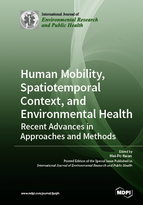Human Mobility, Spatiotemporal Context, and Environmental Health: Recent Advances in Approaches and Methods
A special issue of International Journal of Environmental Research and Public Health (ISSN 1660-4601). This special issue belongs to the section "Environmental Health".
Deadline for manuscript submissions: closed (30 November 2018) | Viewed by 137495
Special Issue Editor
Interests: environmental health; human mobility; healthy cities; social justice; GIScience
Special Issues, Collections and Topics in MDPI journals
Special Issue Information
Dear Colleagues,
Environmental health researchers have long recognized the importance of geographic context for understanding the effects of different environmental factors on human health. While geographic context and neighborhood effects are fundamental constructs for assessing people’s exposure to contextual or environmental influences, they still tend to be conceptualized largely in static spatial terms, which ignores that people move around in their daily lives and come under the influence of many different neighborhood contexts outside their residential neighborhoods. Past studies also tend to ignore the role of human mobility at various spatial and temporal scales (e.g., daily travel, migratory movements, and movements over the life course) in various health issues. They tend to ignore the temporality of exposures that shapes people’s exposure to environmental influences and subjective wellbeing such as the duration, frequency, and recency of exposure, as well as residential history and cumulative exposure over the life-course.
Recent studies, however, have started to incorporate human mobility, non-residential neighborhoods, and the temporality of exposures through collecting and using data from GPS, accelerometers, mobile phones, various types of sensors, and social media. Innovative approaches and methods have also emerged. This Special Issue aims to showcase studies that use new approaches, methods, and data to examine the role of various forms of human mobility, non-residential contexts, and the temporality of exposures on human health behaviors and outcomes. Studies that illustrate the use of these new methods and data to address questions concerning a wide range of health behaviors and outcomes are welcome. These include but are not limited to individual exposure to air pollution, access to green/blue spaces and subjective wellbeing, environmental influences on physical activity, food environmental and diet behavior, psychosocial stress and drug use behavior, socio-environmental factors that affect sleep patterns and sleep hygiene, risk factors that influence mental health and suicide mortality, exposure to noise and stress, and broader social issues such as environmental justice, health disparities, and racial/ethnic segregation.
Prof. Dr. Mei-Po KwanGuest Editor
Manuscript Submission Information
Manuscripts should be submitted online at www.mdpi.com by registering and logging in to this website. Once you are registered, click here to go to the submission form. Manuscripts can be submitted until the deadline. All submissions that pass pre-check are peer-reviewed. Accepted papers will be published continuously in the journal (as soon as accepted) and will be listed together on the special issue website. Research articles, review articles as well as short communications are invited. For planned papers, a title and short abstract (about 100 words) can be sent to the Editorial Office for announcement on this website.
Submitted manuscripts should not have been published previously, nor be under consideration for publication elsewhere (except conference proceedings papers). All manuscripts are thoroughly refereed through a single-blind peer-review process. A guide for authors and other relevant information for submission of manuscripts is available on the Instructions for Authors page. International Journal of Environmental Research and Public Health is an international peer-reviewed open access monthly journal published by MDPI.
Please visit the Instructions for Authors page before submitting a manuscript. The Article Processing Charge (APC) for publication in this open access journal is 2500 CHF (Swiss Francs). Submitted papers should be well formatted and use good English. Authors may use MDPI's English editing service prior to publication or during author revisions.
1. If you are a potential author of this Special Issue; or 2. If you are interested in this Special Issue, but cannot submit a paper at this time; We encourage you to join our reviewer database at: https://susy.mdpi.com/volunteer_reviewer/step/1 When you help to review other manuscripts in this Special Issue, you will be offered a voucher reduction from the APC for each valid review, which can be used immediately for your current submission, or for your future submissions to any MDPI journal.
Keywords
- human mobility
- environmental exposures
- geographic context
- temporality of context
- neighborhood effects
- the uncertain geographic context problem
- the modifiable areal and/or temporal unit problem
- life-course perspectives
- GPS data
- accelerometer data






